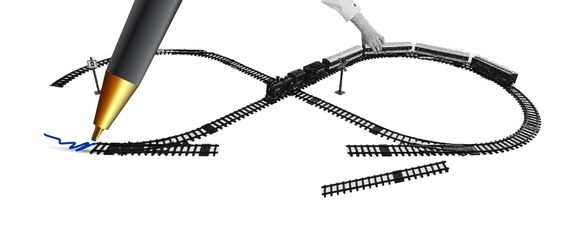

Illustration by Armine Shahbazyan.
On February 7, 1899, a train pulled into the newly-built station in Gyumri, then called Alexandropol. It had set out from Kars, at that time the capital of the Karsskaya Oblast of the Russian Empire. Its arrival heralded the beginning of over 90 years of Armenia’s railroads providing the essential artery to the country’s exchange of goods and people with the outside world. In the aftermath of the First Karabakh War, this lifeline was stymied by Turkey and Azerbaijan closing their borders with Armenia, with a further blow being dealt during the 1992-93 war in Abkhazia, which led to the closure of the railway connection between Georgia and Russia. Now, in the aftermath of the 2020 Artsakh War, a reopening is in the cards.
Article 9 of the November 10, 2020 ceasefire agreement between Armenia, Azerbaijan and Russia stipulates that “All economic and transport links in the region shall be unblocked. The Republic of Armenia shall guarantee the safety of transport links between western regions of the Republic of Azerbaijan and the Nakhichevan Autonomous Republic with a view to organizing the unimpeded movement of citizens, vehicles and cargo in both directions.” While the point specifies only the opening of road and rail connections between Azerbaijan and its western exclave, the first sentence calling for the unblocking of “all economic and transport links” has been widely interpreted as the first step to ending Armenia’s railway blockade.
It is important to clarify that, contrary to President Aliyev’s recent statement, there is no provision for a “corridor” of any kind through Armenian territory. The agreement simply guarantees the passage of Azerbaijani passengers and cargo to and from Nakhichevan, without specifying how this will be achieved. While the disagreement here is specifically over the more logistically complex issue of the road link, negotiations over the railway could be seriously hampered if Aliyev demands an Azerbaijani corridor through Syunik, something which Armenians would find very difficult to accept.
Given that PM Pashinyan and President Aliyev both stated on January 11, 2021, that Armenia will have rail access to Russia and Iran, the issue seems cut and dried. However, Richard Giragosian, who heads the Regional Studies Center (RSC), a Yerevan-based geopolitical think tank, gave a more cautious assessment. “This may be yet another opportunity for Armenia to miss an opportunity,” he remarked, a view which stems from his concern that the Armenian government has thus far shown itself to be “as unprepared for diplomacy as we were for the war.” Giragosian is concerned that the Armenian negotiators don’t seem to have a coherent core strategy for what they want to achieve in the talks, and that they need to come up with a clear plan for tying access to Nakhichevan to guarantees of Armenian access to Russia and Iran, as well as to the release of the POWs who remain in Azerbaijani captivity.
It is important to bear in mind that, if the Armenian government can see these talks through to a satisfactory conclusion, the financial rewards may turn out to be plentiful. According to data from the Observatory of Economic Complexity, Russia currently accounts for 22% of Armenia’s exports and 28.7% of its imports. At present, the vast majority of the physical trade between the two countries occurs by road and has to pass through the Upper Lars checkpoint between Russia and Georgia. This route is often closed in winter due to inclement weather, and is also subject to political uncertainty: the crossing was shut from 2006 to 2010 due to heightened tensions between Russia and Georgia, which spilled over into war in 2008. There is a rail ferry from the Georgian port of Poti to Port Kavkaz in Russia’s Krasnodar Krai region, but this option is far more expensive than straightforward rail transport.
A 2014 report by British NGO International Alert estimated the cost of repair of the Armenian railway section between mainland Azerbaijan and Nakhichevan to be $61.5 million. Of course, this represents a significant sum, but when compared to the cost of other large-scale infrastructure projects, it is a drop in the ocean. The report estimates that annual traffic of 1.5 million tons of cargo along this section would bring in $2.95 million in revenue. It remains to be seen how that pie will be split – since 2008, the railroads of Armenia have been owned and operated by South Caucasus Railway (SCR), a subsidiary of Russian Railways (a Russian state-owned entity). However, the current contract between SCR and the Armenian Government does not include operations on the Syunik branch, simply listing it as an “unused line.”
While the revenues from the line’s operations are a bonus, there is still a large question mark hanging over the source of funding for the repair works. Maintenance of the Syunik section is not included in the current SCR contract with the Armenian government. If the repairs are paid for with Armenian public funds, Pashinyan leaves himself open to the accusation that he is using Armenian taxpayer cash to build a railway for Azerbaijan. The Armenian PM will therefore likely be keen to obtain funding for the project from an external source.
Richard Giragosian believes that supranational institutions such as the Asian Infrastructure Investment Bank (AIIB), World Bank and the European Bank for Reconstruction and Development (EBRD) can be roped in to finance the costs, stating that he believes there is “pressure on much of the West to repair and recover its image, given its deafening silence during the 44 days of war.” Giragosian also floated the possibility of Azerbaijan’s state oil fund being tapped for reconstruction funds. This option is rather unlikely, but not totally implausible given the urgency with which Azerbaijan has pressed ahead on the railway issue. Another option, of course, is that SCR pays for the repairs with funds from its parent company, Russian Railways, which is fully owned by the Russian state. Giragosian points out that the opening of transport links in the region is “much more of a priority for Russia” than Armenia, as “it will take control, more than it has control already” of Armenia’s infrastructure, and thus the Kremlin probably won’t balk at the relatively small cost of repairing the line.
The opening of the line through Nakhichevan to Armenian rail traffic will also likely establish a boom in trade with Iran, thanks to the connection to Tabriz through Julfa. There is a change of gauge required for the narrower railways of Iran (1435 mm as opposed to Armenia and Azerbaijan’s 1520 mm Russian-standard gauge), but fortunately the changing station is located on the Iranian side of the border, which will help minimize difficulties during negotiations and any tensions which may arise after operations commence.
In a January 2021 meeting with his Armenian counterpart Vahan Kerobyan, Iranian Finance Minister Farhad Dejpasand stated that he believes trade between the two countries can reach $1 billion a year, way up from the current $300 million. This is an extremely ambitious target, but a significant uptick in trade volumes seems likely when one considers that all traffic to and from Iran must currently go through the Meghri-Kapan-Goris highway, which is not only perilous and often closed in winter, but also passes through sections of territory now controlled by Azerbaijan.
The significance of the railway connection with Iran would not be limited to direct trade with Iran itself. It could become a transit link between Asia and the Black Sea. If trains are permitted to run through Julfa and Nakhichevan into Armenia, it will greatly shorten the current rail journey from Iran to the Georgian ports of Poti and Batumi. This will allow containers from all over Asia to be transported by rail from the southern Iranian port of Bander Abbas, through Armenia, to their destinations on the Black Sea. It will also significantly increase capacity on the Iran-Black Sea route, as the current path necessitates taking a rail ferry across Lake Van. It is worth noting that the Armenian side should move quickly on this issue if it wants to reap the rewards, as construction is currently underway on a new railroad between the Iranian cities of Rasht and Astara, which will give Iran a direct rail link to Baku, Tbilisi and Kars.
The Armenian Government must therefore quickly shape a coherent and powerful vision of what it wants to gain from the transport talks. If their team gets it wrong, the country is at risk of being outmaneuvered by Azerbaijan and taken advantage of by Russia. Armenia must insist on a rapid and full unblocking of rail connections to Russia and Iran through Nakhichevan and mainland Azerbaijan. The funding issue should be wielded as a bargaining chip without becoming a sticking point in itself; the cost of repairs will be quickly repaid by the expansion in trade, but the pecuniary question should be put on the table as a means of expediting the return of the remaining Armenian POWs. One also must not forget the peace-building importance of the railway: Armenians and Azerbaijanis will have to work together every day to transport thousands of tons of cargo. Will success here serve as an ice-breaker for future normalization efforts?
The Meghri Corridor: A Viable Transport Link or Geopolitical Noose?
Azerbaijan and Turkey are highly incentivized to make the Meghri corridor a reality as soon as possible. For Azerbaijan it’s to have a direct link with its exclave of Nakhijevan. For Turkey, it opens up a direct connection with Azerbaijan and the Turkic world beyond.
Read moreOpening Borders: Armenia’s Economic Risks
The lifting of blockades is presented as a benefit for Armenia, but some business leaders doubt that the Government is prepared for accompanying risks to the Armenian economy.
Read moreRoots of the Demarcation Issue
The November 10 ceasefire agreement ended the 2020 Artsakh War, but the issue of demarcating the new state borders between Armenia and Azerbaijan has been a major concern since then.
Read moreRussia’s Partnership With Turkey and What It Means for Armenia
Many assumed that Turkey’s direct involvement in the 2020 Artsakh War and thereby its intrusion into Russia’s “near abroad” would be met with hostility by Russia, or at least vocal condemnation. The reaction was mild, writes Zaven Sargsian.
Read moreCan Trade Prevent War?
Given the growing sense of global multipolarity and the apparent twilight years of the American-anchored liberal international order, Armenia cannot solely rely on friends and allies around the globe to ensure its survival. A more realistic approach is necessary.
Read more





